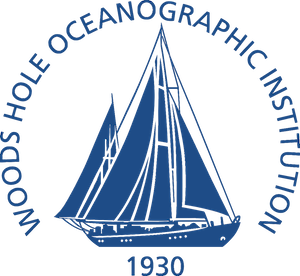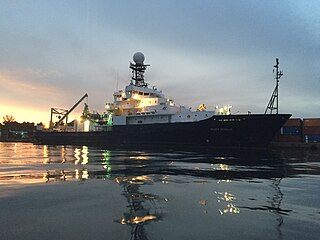
The Woods Hole Oceanographic Institution is a private, nonprofit research and higher education facility dedicated to the study of marine science and engineering.

Alvin (DSV-2) is a crewed deep-ocean research submersible owned by the United States Navy and operated by the Woods Hole Oceanographic Institution (WHOI) in Woods Hole, Massachusetts. The vehicle was built by General Mills' Electronics Group in Minneapolis, Minnesota. Named to honor the prime mover and creative inspiration for the vehicle, Allyn Vine, Alvin was commissioned on June 5, 1964. The submersible is launched from the deep submergence support vessel RV Atlantis (AGOR-25), which is also owned by the U.S. Navy and operated by WHOI. The submersible has made more than 5,000 dives, carrying two scientists and a pilot, to observe the lifeforms that must cope with super-pressures and move about in total darkness, as well as exploring the wreck of Titanic. Research conducted by Alvin has been featured in nearly 2,000 scientific papers.

A research vessel is a ship or boat designed, modified, or equipped to carry out research at sea. Research vessels carry out a number of roles. Some of these roles can be combined into a single vessel but others require a dedicated vessel. Due to the demanding nature of the work, research vessels may be constructed around an icebreaker hull, allowing them to operate in polar waters.

NOAAS Ronald H. Brown is a Thomas G. Thompson-class blue-water research vessel of the U.S. National Oceanic and Atmospheric Administration, she is NOAA's only Global-Class research ship.

RV Knorr was a research vessel formerly owned by the U.S. Navy and operated by the Woods Hole Oceanographic Institution for the U.S. research community in coordination with and as a part of the University-National Oceanographic Laboratory System (UNOLS) fleet. On March 14, 2016, Knorr was officially transferred to the Mexican Navy and renamed Rio Tecolutla. She was replaced at Woods Hole by the RV Neil Armstrong. Knorr is best known as the ship that supported researchers as they discovered the wreck of the RMS Titanic in 1985. R/V Knorr (AGOR-15) has traveled more than a million miles—the rough equivalent of two round trips to the Moon or forty trips around the Earth. Her sister ship is the RV Melville.

R/V Oceanus is a Regional Class research vessel owned by the National Science Foundation, based in Newport, Oregon, and maintained and operated by Oregon State University. The ship was originally delivered to the Woods Hole Oceanographic Institution (WHOI) for operation as a part of the U.S. Academic Research Fleet as a University-National Oceanographic Laboratory System (UNOLS) designated operator. in November, 1975. Oceanus made the first operational cruise in April, 1976 and operated under WHOI for thirty-six years in the Atlantic with some operations in the Mediterranean and Caribbean. The ship was scheduled to be retired in November 2011 but instead was transferred to Oregon State University, College of Earth, Ocean, and Atmospheric Sciences, for operation, replacing sister ship, R/V Wecoma.

R/V Roger Revelle is a Thomas G. Thompson-class oceanographic research ship operated by Scripps Institution of Oceanography under charter agreement with Office of Naval Research as part of the University-National Oceanographic Laboratory System (UNOLS) fleet. The ship is named after Roger Randall Dougan Revelle, who was essential to the incorporation of Scripps into the University of California San Diego.

R/V Thomas G. Thompson (AGOR-23), an oceanographic research vessel and lead ship of her class, is owned by the United States Office of Naval Research and operated under a bareboat charterparty agreement by the University of Washington as part of the University-National Oceanographic Laboratory System (UNOLS) fleet.

Jason is a two-body remotely operated vehicle (ROV) designed, built, and operated by the National Deep Submergence Laboratory of the Woods Hole Oceanographic Institution (WHOI). Construction of Jason began in 1982 and was first launched in 1988, redesigned in 2002 as the second iteration of the ROV. The ROV allows scientists and explorers to have access to the seafloor without leaving the deck of a ship.

A multibeam echosounder (MBES) is a type of sonar that is used to map the seabed. It emits acoustic waves in a fan shape beneath its transceiver. The time it takes for the sound waves to reflect off the seabed and return to the receiver is used to calculate the water depth. Unlike other sonars and echo sounders, MBES uses beamforming to extract directional information from the returning soundwaves, producing a swath of depth soundings from a single ping.

NOAAS Thomas Jefferson is a National Oceanic and Atmospheric Administration (NOAA) hydrographic survey vessel in service since 2003. The ship was built for the United States Navy as USNS Littlehales (T-AGS-52) serving as one of two new coastal hydrographic survey vessels from 1992 until transfer to NOAA in 2003 when it was named after Founding Father and third U.S. president, Thomas Jefferson.

USS Chain (ARS-20/T-AGOR-17) was a Diver-class rescue and salvage ship commissioned by the U.S. Navy during World War II. Her task was to come to the aid of stricken vessels.

PNA Dr. Bernardo A. Houssay (MOV-1) is a ketch rigged sail training and research vessel for the Argentine Naval Prefecture. Originally named the RV Atlantis, she served as the first and main research vessel for the Woods Hole Oceanographic Institution from 1931 to 1966. Several ships, including RV Atlantis (AGOR-25) and the Space ShuttleAtlantis (OV-104) were named after Atlantis. Having sailed over 1,300,000 miles to date, she is the oldest serving oceanographic research vessel in the world.

Thomas G. Thompson (T-AGOR-9) was a Robert D. Conrad-class oceanographic research ship acquired by the U.S. Navy in 1965. The ship was transferred to the University of Washington for operation as part of the University-National Oceanographic Laboratory System (UNOLS) fleet on 21 September 1965. In 1988 the ship went out of UNOLS service. The ship, retaining the previous name, was designated by the Navy as IX-517 assigned to the Mare Island Naval Shipyard for general naval research. Thomas G. Thompson was later renamed Pacific Escort II with the same designation. On 7 May 1997 the Navy renamed the ship Gosport and transferred the ship to the Norfolk Naval Shipyard available for hire as a multi purpose platform from the shipyard. The ship, placed out of service and struck from the register on 27 February 2004, was sunk as part of a NATO exercise 14 November 2004.

Thomas Washington (T-AGOR-10) was a Robert D. Conrad-class oceanographic research ship delivered to the U.S. Navy in 1965. The ship was owned by the Navy but assigned to the Scripps Institute of Oceanography, University of California, La Jolla, California and operated as R/VThomas Washington from delivery to inactivation.
Gyre (T-AGOR-21), best known as RV Gyre, was the lead ship of her class of oceanographic research ships acquired by the U.S. Navy in 1973 for assignment to the University-National Oceanographic Laboratory System (UNOLS) fleet of Navy owned ships. Gyre was operated by the Texas A&M University School of Oceanography as part of the Navy owned UNOLS fleet until stricken 17 August 1992 and transferred to the university under a program transferring ships to states, schools and other public institutions. The university operated the ship until sale in December 2005.

RV Kilo Moana (AGOR-26) is a small waterplane area twin hull (SWATH) oceanographic research ship owned by the US Navy and operated by the University of Hawaii as a part of the University-National Oceanographic Laboratory System (UNOLS) fleet. She was designed to operate in coastal and blue water areas. The unique SWATH hull-form provides a comfortable, stable platform in high sea conditions.
The University-National Oceanographic Laboratory System (UNOLS) is a group of academic institutions and National Laboratories organized in the United States to coordinate research vessel use for federally funded ocean research.

Anton Dohrn was a motor yacht built during 1911 and delivered to the Carnegie Institution of Washington in June 1911 for use at its Department of Marine Biology laboratory at Dry Tortugas, Florida. The institution leased the vessel to the United States Navy for use as a patrol boat during World War I to serve as USS Anton Dohrn 5 October 1917 – 2 January 1919. The vessel remained in service for the institution until 1940 when Anton Dohrn was given to the Woods Hole Oceanographic Institution which used the vessel until 1947 for work between the Gulf of Maine and New Jersey. In 1947 the vessel was sold for use as a mail boat between New Bedford and Cuttyhunk Island.

RV Clifford A. Barnes was a research vessel that was owned by the National Science Foundation and operated as part of the University-National Oceanographic Laboratory System fleet. The University of Washington School of Oceanography operated the vessel under a charter-party agreement.



















